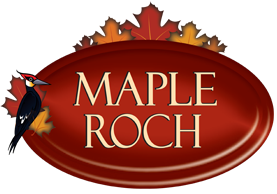Maple Roch Syrup

Blending passion with the tradition and purity of Canadian maple syrup, Maple Roch is a British Columbia-based farm to table enterprise, dedicated to offering maple syrup in its purest, most natural form.
Our maple syrup is single forest meaning it comes from one forest and it is not mixed with other syrups or fillers. This allows our maple syrup to taste just as it should; as if it were harvested from the tree and boiled right in front of you.
Maple Roch syrup is Canada's best organic, single forest maple syrup and is harvested by the same dedicated families year after year.
Based in Summerland, British Columbia, we are proud to offer the highest quality organic maple syrup, whose flavour is a true Canadian experience.
What Makes Our Maple Syrup Different
While over 90% of Canadian maple syrup is produced in Quebec, most of our small batch maple syrup is produced in Saint-Quentin, New Brunswick; a town of approx. 2200 people. Saint-Quentin is found in the Appalachian Mountains, where sugar maple trees grow naturally in ancient forests embedded in the rich, moist montane soils. This location provides a soil profile that is perfect for growing sugar maples, as they require deep, moist, well-drained acidic soil.
Most of our maple syrup is harvested by maple-harvesting families in Saint-Quentin who produce the highest possible quality single-blend, organic maple syrup for Maple Roch.
It is also important to note that we offer single forest maple syrup, which is hard to find.
Commercial maple syrup is typically mixed with other syrups and sugar fillers to produce quantity over quality. Maple Roch syrup is never mixed with sugars or fillers and you can taste that difference.

How is it Maple Roch syrup harvested?
1. Tapping the trees
In February and March, when the temperature allows the maple sap to naturally run, sugar maple trees are carefully tapped in strict compliance with the standards set by Ecocert Canada for organic food. A spout is plugged into a hole, gently bored in the tree and then it is connected to a tubing system to collect the maple sap.
2. Collecting maple water
In March and April, when below-freezing night temperatures (ideally -6◦C) alternate with above-freezing day temperatures (ideally +6◦C), the three sap is collected following organic procedures. The tubing system carries the maple water towards the collecting stations from where it is transferred to the processing plant in tank trucks.
3. Reverse osmosis water extraction
Reverse osmosis is a method used for reducing both boiling time and energy consumption when turning the maple sap into maple syrup. By separating and extracting pure water from maple sap, the procedure concentrates the sugars naturally present in sap. The concentrated maple water is then transformed into maple syrup.
The maple water concentrate is then boiled into syrup. The equipment used is called an evaporator. Three evaporators are used during the production season to make all of the maple syrup.
5. Filtration, grading and barrel storage
Once the syrup reaches the desired boiling point, it is then transferred to the filter press where any impurities are removed in order to obtain 100% pure maple syrup. The maple syrup is finally stored in barrels and is graded according to international standards.
In May, once the sugaring season is over, producers put away the tubing system and carefully remove the spouts from the trees.
Maple Roch maple syrup is truly a Canadian masterpiece in its hand-crafted, small-batch quality and distinct, single forest flavour.
Time-honoured traditions have left the recipe unchanged: gather what the forest gives and maintain its purity to truly enjoy the untouched history in its flavour.
Showcasing quality and community, from the heart of the Okanagan.
Amber & dark maple syrup have the same nutritional value.
